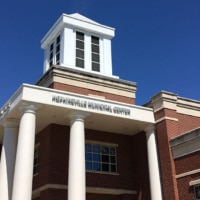As Kentucky schools work toward reopening amid the covid-19 pandemic, new guidance from the state says students and staff will have to stay six feet away from each other, wear cloth masks and have their temperatures checked when they arrive at school.
The Healthy at School guidance released Wednesday by Gov. Andy Beshear’s administration provides five “safety expectations that must be implemented by schools.” Those are social distancing, face coverings, health screenings, sanitation, and contact tracing.
Interim Education Commissioner Kevin Brown said wearing a mask has become a “divisive issue in our commonwealth and in our country,” but stressed that all the rules are designed to keep both students and adults safe at school.
He pointed to Josh Page, a welding instructor at Monroe County Area Technology Center, who recently died from covid-19 at the age of 47.
“Our welding instructors, our students, our teachers, our staff . . . deserve to work and learn in an environment with reduced risk of a disease without a vaccine and without a treatment,” he said. “That’s why the document we are releasing today is so important and that’s why I know that our districts and our teachers are going to act in good faith to reopen our schools with these expectations.”
Brown called on community members and leaders to model mask wearing and social distancing, noting that students will generally comply with what society expects of them.
“If a student is moving, they need to have a mask on,” Brown said. “If they’re less than six feet [apart], they need to have a mask on. When they are on a bus, they need to have a mask on.”
Lt. Gov. Jacqueline Coleman, a former teacher who is secretary of the Education and Workforce Development Cabinet, also spoke to the importance of keeping the adults who work in schools safe. She noted the covid-19 deaths of Grant County school workers Garylin “Stoney” Stone, 71, and Jo Ann Banks, 56, and Fayette County school bus driver Eugenia Weathers, 56, who was infected with 16 other employees.
Asked what she would say to students who refuse to wearing masks, Coleman said, “I would very simply say that wearing a mask is more comfortable than wearing a respirator.”
Brown said requiring masks on school buses rather than social distancing will allow them to be fully loaded. That was a huge concern of superintendents as they tried to figure out how to get students to school in a safe way that is also logistically and financially practical.
Brown said there is also a six-foot social-distancing rule for classrooms, but if districts are unable to accommodate it, students will be allowed to sit closer together if they wear masks.
He said hallways must be taped every six feet for distancing, just as in stores. The general rule is, “When you move, you mask,” he said.
Masks are only required for students in first grade and above, unless they have a medical waiver.
Parents are also expected to make sure their children don’t have a temperature above 100.4 degrees F. before they put them on the bus, even though all students will have their temperatures checked once they get to school.
Brown said children should stay home — or will be sent home — if they have a temperature higher than 100.4; a cough, vomiting or diarrhea; a new rash; or if they have been exposed someone with covid-19 in the last 48 hours. Schools and school buses will have extra masks on hand for students who forget them.
The guidance also includes general instructions for sanitation, and says schools will need to work with health departments to help track down people who have had contact with people who have tested positive for the virus.
Coleman said the guidance allows a great deal of flexibility to support districts as they implement these safety expectations. “We are allowing the flexibility to school districts to resume educational services as they see fit,” she said.
For example, she said some school districts have already decided to start the school year digitally because that is what the students and parents in their school district wants. Others, she said, are talking about doing an “A/B schedule,” in which half of the students attend in person each day and participate in digital learning when at home.
“We want to support these districts to be able to make the decisions that are best for them,” Coleman said. The guidance includes “Best practices,” defined as “additional strategies that schools may choose to follow in order to optimize the safety of students and staff.”
Asked why there aren’t more detailed metrics for schools to follow, Health Commissioner Steven Stack said, “We’ve tried to be very careful about not offering false precision where it doesn’t exist. . . . So I think it is going to continue to require people to use the best science and knowledge available at the time coupled with professional judgement and good faith, trying to do the right thing.”
Coleman also announced that the state is again waiving the cap on non-traditional instruction days to give districts flexibility on distance learning and will suspend statutory requirements to base funding on average daily attendance to allow schools to transition to nontraditional instruction if needed.
Melissa Patrick is a reporter for Kentucky Health News, an independent news service of the Institute for Rural Journalism and Community Issues, based in the School of Journalism and Media at the University of Kentucky, with support from the Foundation for a Healthy Kentucky. She has received several competitive fellowships, including the 2016-17 Nursing and Health Care Workforce Media Fellow of the Center for Health, Media & Policy, which allowed her to focus on and write about nursing workforce issues in Kentucky; and the year-long Association of Health Care Journalists 2017-18 Regional Health Journalism Program fellowship. She is a former registered nurse and holds degrees in journalism and community leadership and development from UK.






